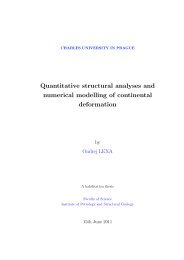PhD. thesis - Univerzita Karlova
PhD. thesis - Univerzita Karlova
PhD. thesis - Univerzita Karlova
You also want an ePaper? Increase the reach of your titles
YUMPU automatically turns print PDFs into web optimized ePapers that Google loves.
3.3. Cretaceous transpressional deformation - Trans-Gemer Shear Zone<br />
(TGSZ)<br />
The transpressional deformation is marked by development of a several kilometer wide<br />
zone of NE-SW trending steep cleavage along the southern boundary of the western Vepor<br />
promontory (Fig. 5b). Here, in the Gemer Unit, Carboniferous and Permian cover of the Vepor<br />
basement and Mesozoic rocks of the Meliata accretionary wedge, all previously developed<br />
structures, are intensively reworked under lower greenschist facies conditions. In the strongly<br />
attenuated Gemer Unit, relics of E-W trending GCF fabric and new NE-SW trending cleavage<br />
form a map-scale sigmoidal domain surrounded by highly sheared Late Paleozoic rocks<br />
(Fig. 5b). Locally, the early-developed foliation is refolded by synschistose noncylindrical<br />
folds with steeply to subhorizontally plunging hinges, which become subparallel to horizontall<br />
stretching lineations with increasing finite strain (Fig. 4d). These features are consistent with<br />
progressive folding in transpressional shear zones [Fossen and Tikoff, 1998; Treagus and<br />
Treagus, 1992].<br />
The boundary of the Vepor basement and Late Paleozoic cover is intruded by sheets of<br />
peraluminous granites, which show magmatic fabric parallel to the transpressional shear zone.<br />
In some places, heterogeneous, steep NE-SW trending mylonitic S-C fabric indicates sinistral<br />
shearing. Granite apophyses and dikes are folded and sheared or they crosscut the foliation of<br />
host rocks without internal deformation. All these features are consistent with syntectonic<br />
character of granite emplacement. Shallow level of magma emplacement is documented by<br />
contact metamorphism of host Late Paleozoic schists [500°C and 2 kbars, Vozárová, 1990].<br />
Towards the NE, this 5 km wide zone of steep cleavage continues into central part of the<br />
Gemer Unit (Figs. 3a, 4e). This NE-SW trending zone of shear deformation - the Trans-Gemer<br />
Shear Zone (TGSZ) overprints all previously developed metamorphic fabrics exhibiting a 20 to<br />
25 km sinistral offset of lithological stripes and axial zone of GCF. The displacement and<br />
intensity of deformation gradually vanishes towards the NE edge of the Gemer Unit.<br />
Two several kilometers wide NE-SW trending zones of greenschist facies<br />
transpressional deformation affected internal parts of the Western Vepor promontory (Fig. 5b).<br />
Inside these shear zones, the Variscan as well as Mesozoic mylonitic extensional fabric are<br />
strongly refolded and transposed. The character of folding as well as numerous sense of shear<br />
criteria underline the sinistral sense of movement. These zones are preferentially developed in<br />
weak lithologies such as garnetiferous micaschists or highly anisotropic extensional mylonites.<br />
Outside of these shear zones, weak E-W trending crenulation cleavage affects flat Cretaceous<br />
extensional mylonitic foliation. The structural mapping shows anticlockwise rotation of this<br />
25







